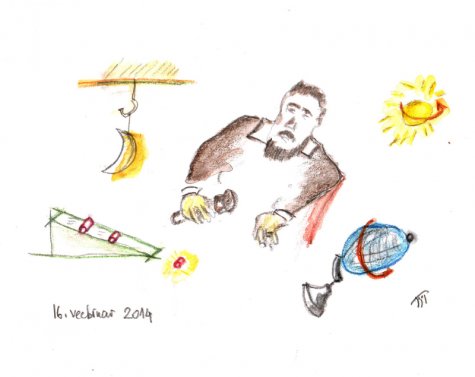Backyard potter's tales
Backyard Potterer’s diary: remember the Universal Uncle
Text and drawing Tiit Kändler
Translation: Liis
Galileo: 450 years of first experimental physicist
450 years ago, on February 15th or 16th 1564, the son Galileo of musician and music theoretician Vincenzo Galilei and his wife Giulia Ammannati, daughter of a cloth merchant, was born.
Three negatives:
I Galileo was not born on the day when Michelangelo died, but six or seven days later.
II Galileo did not invent the telescope, he snatched it from Dutch spectacle makers, forestalling inventor protection rights..
III Galileo did not cry out ”And yet it moves” about the Earth, or if he did, he mumbled it about the Sun.
The first mechanical invention of man was the development of the wedge. Galileo implemented the wedge on an inclined plane, and on it measured that heavier objects fall towards Earth in the same way as lighter ones. It was not as simple an experiment as it might seem – try to repeat it with modern watches using for instance wooden or iron cylinders for rollers. Galileo had only a water clock to use but he managed. He became the first known and historically recorded scientist who proved that experiment is a criterion of truth.
On the first day of December, 1609, Galileo directed his best telescope with 20-fold magnification towards the sky. He saw many things there that had never before been seen with naked eyes but also what had been seen before but about which there were no ideas on what s they were. Sunspots were seen and described by Florentine astronomer and astrologer Gualterotti in 1604. Kepler observed the same spots with a camera obscura in 1607, believing them to be Mercury. Galileo began to observe sunspots in the spring of 1611 and finally reached the conclusion that the Sun rotates round its own axis. ”The Sun has no reason to prefer standing still to rotating” he nicely wrote.
Galileo was no more of a mathematician than he was musician, artist, philosopher so that American science historian John Lewis Heilbron who has written a thorough treatise on him holds that the single most accurate word to describe Galileo is ”critic”. ”Galileo raised the Earth to the Heaven” he writes in his book „Galileo“. The Potterer can plagiarize here that Galileo raised the yard to heaven, the truth of which every yard fan knows with crystal clsrity.
According to Galileo’s mechanics even the slightest force can move the greatest weight given sufficient time. The direction of motion is clear.
So, set to with your shoulder, it will be sure to start moving
.









